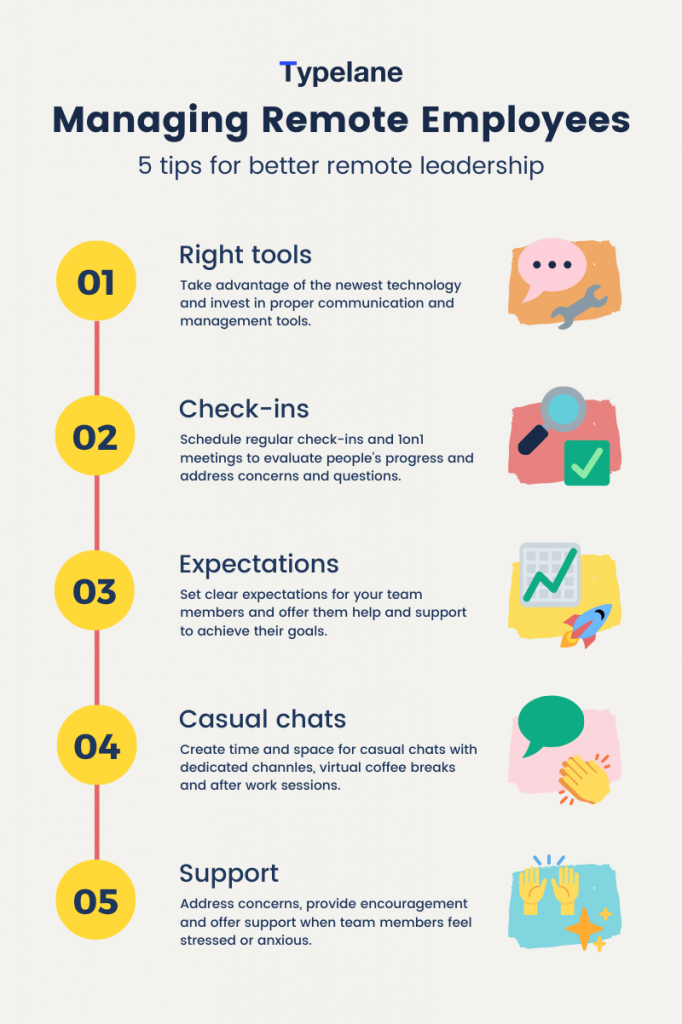Managing remote employees: 5 tips for better remote leadership


Around the world, more than 70 per cent of people work from home at least one day per week. Rates of at-home work have increased by 173 per cent since 2005, and the number s going up. Have you recently started managing a team of remote workers? Whether your team works from home all week long or only a couple of days a week, managing remote employees can be challenging. If you’re having a hard time adjusting, keep reading. Explained below are five tips that will make the process of managing a remote team easier and more effective.
Challenges in managing remote employees
If you’re brand new to remote employee management, you might be unsure of what to expect from working with a group of work-from-home employees. The following are some of the issues on managers’ and HR’s mind:
- Communicating frequently and clearly
- Keeping up with employees’ work and productivity
- Fostering and maintaining a healthy and productive work culture
- Adapting to remote work
- Dealing with uncertainties and supporting employees
- Maintaining morale and engagement
The last point can be especially tricky: it’s often hard to tell how employees are doing in the first place, and it can be even harder to boost morale and help people remain positive and optimistic when you don’t have a chance to see and talk to them in-person each day.
Better remote leadership
Don’t let the potential challenges of leading a remote team scare you away. There are ways to get around these obstacles. Start by trying out these five tips:


1. Use communication and team management tools
There are tons of tools on the market these days that can help managers stay in touch with their distributed team. Proper communication is essential if you want your remote team to succeed and want remote workers to be engaged and productive. Don’t rely on just email because it is insufficient, take advantage of the rich technology that is now available. Look for tools that allow you to communicate with workers in various ways (chat, video, audio, collaboration etc.) such as Slack, Zoom, Google Meet. The more flexibility the tool provides, the easier it’ll be for everyone to use it and stay in touch with one another. In addition to communication tools, look into team management tools such as [Trello](http://www.trello.com), When I Work and even Miro. Many of these tools integrate with chat apps and make it easier for team members to share updates on their current projects.
2. Schedule regular check-ins
When you manage a team on-site, it’s easy to check in with your employees on a daily basis. You can stop by their desk or invite them to your office for a quick chat whenever you want. With a remote team, you have to be more proactive about checking in and seeing how people are doing. Be sure to schedule regular team check-ins, as well as one-on-one meetings to evaluate people’s progress, answer questions, and address concerns. These meetings also provide a great opportunity for goal-setting and for you to work with your employees to help them level up and become greater contributors to the company as a whole. Plan for check-in to occur regularly – once a month or even once a week.
3. Set clear expectations
As a team leader, you should set clear expectations for your team members. During your regular meetings, let them know what you want them to accomplish in the future, and help them figure out a plan to ensure they achieve those goals. You should also let your employees know what they can expect from you; let them know that you’ll be there to help them if they have a question or a concern about a specific project or about the workplace culture as a whole. Remember, the sooner you set expectations, the better. Ideally, you’ll make them clear during the onboarding process; when someone joins your team. Address potential questions right away and continue to check in with them to see if anything needs to be clarified.
4. Encourage casual conversations
Make sure your team members know that casual conversations are okay and encouraged. When working from home, it can be hard to replicate those casual watercooler conversations that take place in a traditional office. Good ways to do this, are to create dedicated chat threads just for these types of discussions, scheduling virtual coffee breaks or even after work sessions. Remember to lead by example and participate in these discussions and events yourself. This shows your employees that it’s okay to have a casual interaction and that they don’t have to be on “work mode” all day long.
5. Support and encourage
Especially when the shift to remote work has happened unexpectedly and some team members can feel more stressed than others, it’s important to offer them support and encouragement. Acknowledging the unusual situation and listening to employees’ concerns is something a great leader invests time in. Often new employees, in particular, don’t necessarily feel comfortable of communicating their worries and anxieties so simply ask how they are doing and feeling is a good way of starting the conversations. Effective leaders also encourage their team and boost confidence by providing affirmation. This kind of emotional intelligence is an important quality of a good leader and even more important when leading a remote team.
Become a better manager today
Remote employee management does present a lot of unique challenges. With some simple adjustments, though, you can become a great leader and help your remote workers be productive to achieve their full potential. Keep these tips in mind and you’ll have a much easier time adjusting to remote team management.
Don’t forget, too, that good management starts early, relationships are established during an employee onboarding. Check out this blog post for more information on the best onboarding tools you ought to consider using in 2020 and beyond to set your new team members up for success.
Sign up for our newsletter!
Fine-tune your knowledge within on- and offboardings with our monthly newsletters.


